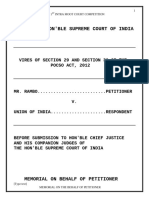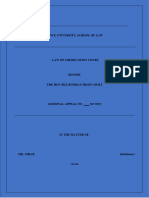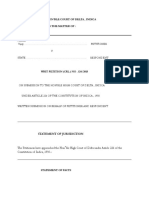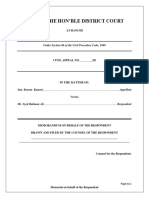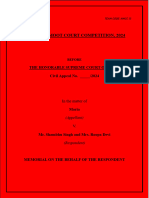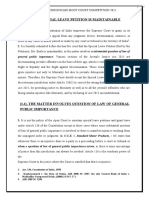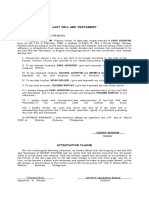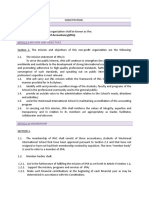Fundamental of Trial Advocacy: Memorial For Respondent
Uploaded by
Yash HenrageFundamental of Trial Advocacy: Memorial For Respondent
Uploaded by
Yash Henrage1
Fundamental of Trial Advocacy
SUPREME COURT OF INDIA
AT NEW DELHI
IN THE MATTER OF
APPELLATE JURISDICTION
ARISISING IN
SIDHARATH VASHISHT @ MANU SHARMA (Appellant)
VS.
STATE (NCT of Delhi) (Respondent)
MEMORIAL FOR RESPONDENT
2
TABLE OF CONTENT
TITLE PG NO:
TABLE OF AUTHORITIES 3
TABLE OF ABBREVIATIONS 4
STATEMENT OF JURISDCTION 5
STATEMENT OF FACTS 6-7
ISSUE RAISED 8
SUMMARY OF ARGUMENTS 9
ARGUMENTS ADVANCED 10-16
PRAYER 17
MEMORIAL FOR RESPONDENT
3
TABLE OF AUTHORITIES
Table of Cases
State of M.P. vs. Ratan Lal
Anthony D'Souza vs. State of Karnataka
Green v. State, 342 So.2d 419, 421 (Ala. Crim. App.1977)
Statutes
1. The Constitution of India,1950
2. The Code of Criminal Procedure, 1973
3. The Indian Evidence Act, 1872
4. The Indian Penal Code, 1860
5. Arms Act, 1959
Data Base
1. www.lawctopus.com
2. Indiankanoon.org
3. www.lawyerservices.in
4. www.casemine.in
MEMORIAL FOR RESPONDENT
4
TABLE OF ABBREVIATIONS
ABBREVIATIONS EXPANSIONS
A.I.R All India Reporters
Crl.A Criminal Appeal
Cr.Pc Criminal Procedure Code
S.C. Supreme Court
H.C. High Court
SEC. Section
SLP Special Leave Petition
Hon’ble Honourable
PW Prosecution Witness
DW Défense Witness
I.P.C Indian Penal Code
MO Material Object
v. Versus
SCC Supreme Court Cases
SCR Supreme Court Reporter
ECC Essential Commodities Case
u/s Under Section
Vol. Volume
Art. Article
MEMORIAL FOR RESPONDENT
5
STATEMENT OF JURISDICTION
The Appellant, private persons Sidharta Vashisht, had filed a Special Leave Petitions under
Article 136 before the Hon’ble Supreme Court. Article 134 of Indian Constitution allows
Appellate Jurisdiction of Supreme Court in regard to criminal matters.
The Respondents respectfully submit themselves to the jurisdiction of this Hon’ble Court
and shall accept the judgment of this Court in its entirety, executing it in good faith.
MEMORIAL FOR RESPONDENT
6
STATEMENT OF FACTS
April 29-30 1999: Jessica shot at a party in Qutub Colonnade restaurant in south
Delhi
April 30, 1999: Doctors at Apollo Hospital declare Jessica brought dead.
May 2, 1999: Delhi Police recover Tata Safari car belonging to Manu Sharma, son
of Haryana Congress leader Venod Sharma, from Noida, Uttar Pradesh.
May 6, 1999: Manu surrenders before a court in Chandigarh. Subsequently, ten
other co-accused including Vikas Yadav, son of UP politician D.P. Yadav, arrested.
August 3, 1999: Charge sheet filed against accused for killing Jessica under various
sections of IPC.
January 31, 2000: Magistrate court commits the case to a Sessions court for trial.
November 23, 2000: Sessions court frames charges for murder against nine persons
and discharges one accused Amit Jhingan while declaring Ravinder Sudan alias Titu
as proclaimed offender.
May 2, 2001: Court starts recording of prosecution evidence. Deepak Bhojwani, an
eye witness deposes before the trial court.
May 3, 2001: Complainant and eye witness Shyan Munshi turns hostile and fails to
identify Manu in court.
May 5, 2001: Another eye witness Shiv Das, an electrician at Qutub Colonnade,
turns hostile.
May 16, 2001: Third key witness Karan Rajput turns hostile.
July 6, 2001: Malini Ramani, eyewitness, identifies Manu.
October 12, 2001: Socialite Bina Ramani, owner of the restaurant and bar,
identifies Manu.
October 17, 2001: George Mailhot, Ramani’s Canadian husband, deposes and
identifies Manu.
MEMORIAL FOR RESPONDENT
7
July 20, 2004: Surinder Sharma, controversial investigating officer in the case,
deposes after returning from U.N. assignment in Kosovo.
February 21, 2006: Trial court acquits all nine accused due to lack of evidence
against them.
March 13, 2006: Delhi Police file appeal in the high court.
October 3, 2006: High Court begins hearing on appeal on a day-to-day basis.
November 29, 2006: High Court reserves its verdict.
December 18, 2006: High Court convicts Manu, Vikas Yadav and Amardeep Singh
Gill alias Tony and acquits Aloke Khanna, Vikas Gill, Harvinder Singh Chopra,
Raja Chopra, Shyam Sunder Sharma and Yograj Singh.
December 20, 2006: High Court awards life imprisonment term to main convict
Manu Sharma with a fine of Rs. 50,000 and also sentences co-convicts Amardeep
Singh Gill and Vikas Yadav to four years’ prison term with Rs. 3,000 fine each.
MEMORIAL FOR RESPONDENT
8
ISSUE RAISED
ISSUE 1: WHETHER THE ACCUSED IS GUILTY OF MURDER?
ISSUE 2: WEATHER THERE WAS TAMPERING OF EVIDENCE
ISSUE 3: WHETHER INTOXICATION COULD BE AS A GROUND OF THE
DISCHARGE OF SIDHARTHA VASHISHT @ MANU SHARMA?
MEMORIAL FOR RESPONDENT
9
SUMMARY OF ARGUMENTS
ISSUE 1: WHETHER THE ACCUSED IS GUILTY OF MURDER?
It is humbly submitted before this Hon’ble Court that the accused is guilty of murder as he
had committed an act of cold blooded murder when he walked into the bar with many
witnesses to the actus reus. The accused had the requisite mens rea to commit said crime, and
he even had a motive to carry out said act. The shot was fired point blank in the centre of the
deceased’s head, thus showing it was indeed an execution and not an act of self-defence or an
accident. Hence it is proven beyond a reasonable doubt that the crime of Murder was indeed
committed by the accused in the case at hand.
ISSUE II: WEATHER THERE WAS TAMPERING OF EVIDENCE
Manu Sharma was fingered as the culprit by numerous witnesses, including Jessica Lal’s fellow
bartender Shayan Munshi, Bini Ramani’s husband, and a handful of others. He was not apprehended
for another week following the incident, and in that time he was helped by friends to hide and to
dispose of the weapon responsible for the attack. During police interrogation, Sharma initially
confessed to the murder. However, the confession was later dismissed as evidence due to a procedural
technicality committed by the police.
Along with police inefficiency, the case was severely compromised by amnesiac flip-flop by
the witnesses. The First Information Report which curiously did not mention Sharma by name,
three witnesses including model-turned-actor Shayan Munshi, who was tending the bar with
Jessica, initially claimed they had seen Sharma gun Jessica down. Two years later, they said
they had not seen anything. "Witnesses were openly purchased,'' said Jessica's sister, Sabrina.
ISSUE 3: WHETHER INTOXICATION COULD BE AS A GROUND OF THE
DISCHARGE OF SIDHARTHA VASHISHT @ MANU SHARMA?
It is most humbly submitted before the Hon’ble Supreme Court that Sidhartha Vashisht @
Manu Sharma cannot be discharged on the ground of intoxication. The accused party had
voluntarily intoxicated himself. Furthermore the crime was committed on the refusal of the
victim to serve further alcohol to the accused.
MEMORIAL FOR RESPONDENT
10
ARGUMENTS ADVANCED
ISSUE 1: WHETHER THE ACCUSED IS GUILTY OF MURDER?
It is humbly contended that the accused is guilty for committing the offence of murder under
Sec 302, IPC. Sec 302 prescribes the punishment for committing murder. In order to bring a
successful conviction under this charge, however, it is pertinent to refer to Sec 300, IPC
which elucidates the essentials of murder. A person is guilty of murder if he intentionally
causes the death of a person or causes such bodily injury as he knows, is likely to cause death
of that person or causes such bodily injury, which in the ordinary course of nature results into
death or commits an act so dangerous that it must, in all probability cause death of that
person31 . The Prosecution humbly contends that both, the actus Reus and the mens rea of
the crime are established in the instant matter, negating any claims of private defence.
2.1 ACTUS REUS OF MURDER IS PROVEN
Actus reus is any wrongful act32. Thus, in a case of murder, actus Reus would be the physical
conduct of the accused that causes death of the victim. In the instant case, the actus Reus is
established by way of witness statements [A], forensic report [B] and ballistic evidence [C].
A. Witness Statements
1. Bearing in mind that it is not for the prosecution to meet any and every hypothesis
suggested by the accused, howsoever extravagant and fanciful it might be,33 it is
humbly submitted before this Hon’ble Court that the circumstantial evidence in the
instant matter shows that within all human probability, the act must have been done
by the accused. According to Sec. 300 of IPC1, as a trained shooter Sidhartha
Vashisht @ Manu Sharma was implied to be aware of his action. He must be aware
his shooting of the bullet such close to Jessica would imminently cause death. As he
claimed that it was shot near his ear to threaten him it in all probability without any
excuse would have cause major bodily injury2.
1
Section 300, Indian Penal Code, 1860-Murder.— If the person committing the act knows that it is so
imminently dangerous that it must, in all probability, cause death or such bodily injury as is likely to cause
death, and commits such act without any excuse for incurring the risk of causing death or such injury as
aforesaid.
2
Section 324 of Indian Penal Code, 1860 - Voluntarily causing hurt by dangerous weapons or means.
MEMORIAL FOR RESPONDENT
11
2. Sidhartha Vashisht @ Manu Sharma attempt to threaten Jessica by firing bullet in the
air and pointing gun towards her resulted in battery3 4 And by shooting the bullet the
moment it touched Jessica’s body it constituted battery5.
3. Thus, Sidhartha Vashisht @ Manu Sharma has committed a murder under Indian
Law.
ISSUE II: WEATHER THERE WAS TAMPERING OF EVIDENCE
The most glaring loophole in the police investigation was the failure to recover the .22 pistol
Sharma had allegedly used to gun Jessica down along with the case of the mixed cartridges.
Sharma apparently fired twice-first at the ceiling of the Tamarind Court and then at Jessica.
The evidence in respect of two FSL reports is as under:
By letter dated 06.07.1999, the seized material was forwarded to CFSL for examination and
expert opinion and, inter alia, the following queries were made to be opined by the CFSL :
Please examined and opine whether the two empties present in parcel mentioned at Sl
No.5 have been fired from the same weapon?
Please examine and opine whether the bullet lead in parcel No.6 and the bullet empties
in parcel No.5 have been fired from a standard five arm or a country made fire arm?
Please examine and opine whether ejector, trigger, chamber, magazine or other
chamber marks are present on the live bullet empties contained in parcel Nos. 6 & 5
respectively.
If answer to query’s is yes then whether these marks are similar and caused by the same fire
arm?" The Ballistics Division of CFSL gave report in respect of the queries:
3
An assault is the act of inflicting physical harm or unwanted physical contact upon a person or, in some
specific legal definitions, a threat or attempt to commit such an action
4
Section 351 of Indian Penal Code, 1860.
5
A battery as the term defines is the intentional touching of or application of force to the body of another person
or anything related to them, in a harmful or offensive manner without the consent of the person.
MEMORIAL FOR RESPONDENT
12
With regard to Prem Sagar Manocha PW-95, Ballistic expert at FSL, Jaipur, a specific query
being query is that whether both the empty cartridge cases have been fired from the same
firearm or otherwise. In the reply to the said query, the expert opined that no definite opinion
could be given on the two .22" bore cartridge cases C-1 and C-2 in order to link with the firearm
unless the suspected firearm is available to examination. It was pointed out that the trial Court
puts a question to the witness and while putting the question first gives a specific fact finding
that for reply to Query No. 3, the presence of the firearm was not necessary. This incorrect
finding of fact given by the trial Court based on no expertise and had resulted in grave
miscarriage of justice. It is well settled that while giving reports after Ballistic examination, the
bullets, cartridge case and the cartridges recovered and weapon of offence recovered are
carefully examined and test firing is done at the FSL by the said weapon of offence and then
only a specific opinion is given.
Counsel represents that the said report of Rup Singh is inadmissible in law since it is a
photocopy and, therefore, does not fall within the purview of a report in terms of Section 293 of
the Code. In other words, in terms of the relevant provisions of the Indian Evidence Act unless
the original document is placed for the scrutiny of the Court, no reliance can be placed on the
photocopy without leading proper secondary evidence in this regard. In any case, both Section
293 and Section 294 of the Code which dispense with formal proof of documents under certain
circumstances make it abundantly clear that the documents sought to be relied upon must be
the originals.
The counsel for respondent represents that the contention of the prosecution was that the trial
Court could not have first put a specific finding of its own opinion to the expert witness and
then ask him questions. Learned Solicitor General pointed out that in the attempt of the trial
Court to extract the truth from the said witness, it misdirected itself in law by posing such a
question. This is impermissible even as per the judgment in Ram Chander (supra) relied on by
the defence. This judgment is in fact in favour of the prosecution since the same clearly puts
an embargo on the power of a judge to ask questions so as to frighten, coerce, confuse or
intimidate the witness. The danger inherent in a judge adopting a much too stern an attitude
towards witness has been duly explained in the said decision. The judge cannot ask questions
which may confuse a witness. The argument that the judge knew that the issue in question was
whether the two empties found on the spot were fired from the same gun is wrong and
misleading. The judge knew that as per the charge framed against Manu Sharma it was he alone
who was charged with the possession and use of a gun. The judge also knew that the first expert
MEMORIAL FOR RESPONDENT
13
opinion was brought on record at the instance of the accused; the judge further knew that PW-
95 had stated in no uncertain terms that no opinion can be given as regards the two empties
without receipt of the weapon of offence. In spite of knowing all this, the judge first put a
finding of its own to the witness that he did not need the firearm in question in order to reply
as to whether the two empties were fired from the same gun i.e., a gun and not the gun. The
Court exceeded its power under Section 165 of the Evidence Act by putting the question after
giving its own finding.
False answers under Section 313 Cr.P.C.
This Court has time and again held that where an accused furnishes false answers as regards
proved facts, the Court ought to draw an adverse inference qua him and such an inference shall
become an additional circumstance to prove the guilt of the accused. In this regard, the
prosecution seeks to place reliance on the judgments of this Court in Peresadi vs. State of U.P.,
(1957) Crl.L.J. 3286, State of M.P. vs. Ratan Lal, AIR 1994 SC 4587 and Anthony D'Souza vs.
State of Karnataka (2003) 1 SCC 259 8where this Court has drawn an adverse inference for
wrong answers given by the appellant under Section 313 Cr.P.C. In the present case, the
appellant-Manu Sharma has, inter alia, has taken false pleas in reply to question nos. 50, 54,
55, 56, 57, 64, 65, 67, 72, 75 and 210 put to him under Section 313 of the Code.
Adverse inference qua non explanation of Pistol Appellant/Accused - Manu Sharma was holder
of a pistol .22" bore P Berretta, made in Italy duly endorsed on his arms license. It was his duty
to have kept the same in safe custody and to explain its whereabouts. It is proved beyond
reasonable doubt on record that extensive efforts were made to trace the pistol and the same
could not be recovered. Moreover as per the testimony of CN Kumar, PW-43, DSP/NCRB, RK
Puram there is no complaint or report of the said pistol. Thus an adverse inference has to be
drawn against the accused-Manu Sharma for non- explanation of the whereabouts of the said
pistol. Similarly another plea not supported by any positive evidence led by the appellant-Manu
Sharma is that his pistol i.e. the weapon of offence and the arms license was recovered from
6
Peresadi vs. State of U.P (1957) Crl.L.J. 328,
7
State of M.P. vs. Ratan Lal AIR 1994 SC 458
8
Anthony D'Souza vs. State of Karnataka (2003) 1 SCC 259
MEMORIAL FOR RESPONDENT
14
his farm house on 30.04.1999, when in fact it is an established fact that the pistol could not be
recovered and that the license was surrendered on 06.05.1999 at the time of his arrest. It defies
all logic and ordinary course of conduct to allege that the prosecution has withheld the pistol
after seizing the same from his farmhouse. The fact that he has failed to produce the pistol, a
presumption shall arise that if he has produced it, the testing of the same would have been to
his prejudice. The burden thus shifts on him.
Adverse inference since no report of theft or loss of Tata safari CH-01-W-6535 It is the defense
of the accused-Manu Sharma that the Tata Safari was taken away on 30.04.1999 from Karnal.
No report or complaint of the taking away of the vehicle or the theft of the vehicle was ever
lodged by the appellant/accused and hence an adverse inference has to be drawn against the
accused on this count as well. Further the conduct of the appellant/accused in not taking any
steps despite opportunity in reporting the alleged taking away of Tata Safari on 30.04.1999 and
his licensed pistol on 01.05.1999 in itself is enough material to draw serious adverse inference
against the accused.
Appearance of PW-2 Shyan Munshi accompanied by Shri Ashok Bansal, Advocate By order
dated 06.03.2000, Shri Ashok Bansal, advocate had appeared as proxy counsel for accused-
Manu Sharma before the trial Court and on the same day also took copy of the report of
FSL/Jaipur on behalf of accused-Manu Sharma. On 03.05.2001, PW-2, Shyan Munshi, was
duly accompanied by Shri Ashok Bansal, advocate wherein he clearly says that he has come
with a lawyer for his personal security. On behalf of the State, it was contended that an adverse
inference against accused- Manu Sharma has to be drawn for influencing the witness. It may
not be out of place to mention here that PW-2, Shyan Munshi, who is the maker of the FIR and
complainant of the case, did not fully support the prosecution case though he admitted having
made statement to the police and having signed the same. The stand of the State cannot be
ignored, on the other hand, it is acceptable.
"We also find the criticism against him to be a matter of meaningless hair splitting. There is a
ring of truth around the deposition of PW 30 whom we find a reliable witness. The trial Court,
while dealing with this witness, has, with great respect, termed him as a `planted witness'. This,
we find, is not justified from material on record. The cursory manner in which the witness has
been discarded shows a lack of proper appreciation of evidence. Once a reasonable explanation
has been given by a witness for his presence at the spot, there was hardly any reason to stretch
imagination to belie his presence. Merely, because he was assigned to deliver a DD entry to SI
MEMORIAL FOR RESPONDENT
15
Rishi Pal which, the witness explains, he did not deliver, the explanation given is logical and
ought not to have been disbelieved in this strange way of assessing the material and discarding
it."
The two weapon theory appears to be a concoction to the defense and a manipulation of
evidence in particular that of Shyam Munshi, PW2 who, for the first time in court, introduced
such a story. The very fact that the empties were sent for examination at such a belated stage,
cannot rule out the possibility of foul play to destroy the Prosecution's case during trial. We,
therefore, do not think it necessary to go into further analysis of the evidence of Prem Sagar
Manocha."
ISSUE 3: WHETHER INTOXICATION COULD BE AS A GROUND OF THE
DISCHARGE OF SIDHARTHA VASHISHT @ MANU SHARMA?
4. It is most humbly submitted before the Hon’ble Supreme Court that Sidhartha
Vashisht @ Manu Sharma cannot be discharged on the ground of intoxication. The
accused party had voluntarily intoxicated himself. Furthermore the crime was
committed on the refusal of the victim to serve further alcohol to the accused.
5. In general, “voluntary intoxication” describes a situation in which someone drinks
alcohol to excess or takes illegal drugs. The resulting intoxication is voluntary in that
the defendant chose to consume the substances and had reason to know of their
intoxicating effect. 9
6. Voluntary intoxication can disprove the mental state required for a specific intent
offense only if it amounts to insanity. The intoxication must make the requisite mental
state “impossible”—it must be so severe that the defendant is “incapable of
consciousness that he is committing a crime; incapable of discriminating between
right and wrong.”10
9
Hunt v. Comm'r, 666 F.3d 708 (11th Cir. 2012)
10
Green v. State, 342 So.2d 419, 421 (Ala. Crim. App.1977)
MEMORIAL FOR RESPONDENT
16
7. Intoxication is codified under Section 8511 and 8612 of IPC. According IPC section 85
intoxication need to be against one own will, but in the given case Sidhartha Vashisht
@ Manu intoxication was voluntary and the defense of intoxication cannot be taken
into consideration.
8. According to the famous landmark case Basudev vs. State of Pepsu13 an intoxicated
military officer in a marriage meal who was highly drunk, asked a young boy to step
aside, so that he can occupy a convenient seat. But when the boy refused to move, the
officer took out his pistol and shot the young boy. The injury proved fatal.
9. The Supreme Court from the given facts explicitly elucidates that there was no proved
incapacity on the accused to form the intention to cause bodily harm sufficient in the
ordinary course of the nature to cause death. Due to his incapacity to prove his
innocence, the law presumed that he intended the natural and probable consequences
of his act. In other words he intended to inflict bodily injuries on the victim. The
accused was found guilty.14
Thus, due to voluntary intoxication Sidhartha Vashisht @ Manu cannot be discharge of the
murder of Jessica Lal
11
Section 85 of Indian Penal Code, 1860: Act of a person incapable of judgment by reason of intoxication
caused against his will.
12
Section 86 of Indian Penal Code, 1860: Offence requiring a particular intent or knowledge committed by one
who is intoxicated.
13
Basudev vs. State of Pepsu 1956 AIR 488
MEMORIAL FOR RESPONDENT
17
PRAYER
Wherefore, in the light of the facts stated, arguments advanced and authorities cited, it is most
humbly prayed and implored before the Hon’ble Supreme Court of India, that it may be
graciously pleased to adjudge and declare that:
1. CONVICT the accused; Sidhartha Vashisht @ Manu Sharma, Amardeep Singh
Gill, Alok Khanna and Vikas Yadav.
2. FINE lived from the rest of the accused under Section 357 of CrPC 1973
3. UPHOLD the decision and conclusion of the High Court and consequently devoid
any appeals made.
4. DENY SLP requested by the appellants.
Also, pass any other order that it may deem fit in the favor of the RESPONDENT to meet
the ends of equity, justice and good conscience.
For this act of Kindness, the RESPONDENT shall duty bound forever pray.
Date: SD/-
Place: (COUNSEL FOR RESPONDENT)
MEMORIAL FOR RESPONDENT
You might also like
- In The Honourable District and Session Court, Mohali: Memorial Filed On Behalf of The ProsecutionNo ratings yetIn The Honourable District and Session Court, Mohali: Memorial Filed On Behalf of The Prosecution17 pages
- Gang Rape Case Maintainabilty For Moot Court MemorialsNo ratings yetGang Rape Case Maintainabilty For Moot Court Memorials3 pages
- In The Hon'Ble Supreme Court of India: (Criminal Appellate Jurisdiction)No ratings yetIn The Hon'Ble Supreme Court of India: (Criminal Appellate Jurisdiction)18 pages
- Before The Hon'Ble Judicial Magistrate I: Team code-GRMCVA02No ratings yetBefore The Hon'Ble Judicial Magistrate I: Team code-GRMCVA0224 pages
- The Chairman, Railway Board & Ors. V Chandrima Das PDFNo ratings yetThe Chairman, Railway Board & Ors. V Chandrima Das PDF11 pages
- T C: Inrr 84: Internal National Ranking Rounds 2020No ratings yetT C: Inrr 84: Internal National Ranking Rounds 202024 pages
- Team No.: Before The Hon'Ble Supreme Court of Kakila Criminal Appellate Jurisdiction Criminal Appeal of 20No ratings yetTeam No.: Before The Hon'Ble Supreme Court of Kakila Criminal Appellate Jurisdiction Criminal Appeal of 2018 pages
- Laxman Ram Mane V State of Maharashtra PDFNo ratings yetLaxman Ram Mane V State of Maharashtra PDF3 pages
- National Law Institute University Bhopal: Lok Adalat Visit & Mediation Centre VisitNo ratings yetNational Law Institute University Bhopal: Lok Adalat Visit & Mediation Centre Visit5 pages
- Practical Training Kasvi Chetan Thakkar 111 B 9619589520No ratings yetPractical Training Kasvi Chetan Thakkar 111 B 961958952064 pages
- University Institute of Legal Studies, Punjab University, Chandigarh Moot MemorialNo ratings yetUniversity Institute of Legal Studies, Punjab University, Chandigarh Moot Memorial14 pages
- As Part of The Moot Court and Internship Subject For The Students of VIIth SemesterNo ratings yetAs Part of The Moot Court and Internship Subject For The Students of VIIth Semester3 pages
- Aveek Sarkar & Anr. v. State of West Bengal & Ors100% (1)Aveek Sarkar & Anr. v. State of West Bengal & Ors19 pages
- 7th R.C. Chopra Memorial National Moot Court Competition2019 PDFNo ratings yet7th R.C. Chopra Memorial National Moot Court Competition2019 PDF21 pages
- Before The Hon'Ble High Court of Punjab & HaryanaNo ratings yetBefore The Hon'Ble High Court of Punjab & Haryana17 pages
- Symbiosis Law School Pune Maharashtra India Winning Memorial For AppellantNo ratings yetSymbiosis Law School Pune Maharashtra India Winning Memorial For Appellant26 pages
- Team Code - 131: National Law University Delhi Internal Moot Court Competition100% (2)Team Code - 131: National Law University Delhi Internal Moot Court Competition36 pages
- Team Code - 131: National Law University Delhi Internal Moot Court Competition100% (2)Team Code - 131: National Law University Delhi Internal Moot Court Competition36 pages
- The Statutory Derivative Action in MalaysiaNo ratings yetThe Statutory Derivative Action in Malaysia32 pages
- Arbuthnot Latham Bank LTD and Others V Trafa PDFNo ratings yetArbuthnot Latham Bank LTD and Others V Trafa PDF14 pages
- Short Form Consultancy Agreement-GhassanNo ratings yetShort Form Consultancy Agreement-Ghassan6 pages
- An Introduction To International Commercial Arbitration Final100% (1)An Introduction To International Commercial Arbitration Final17 pages
- Lecture 2 - English Law and Civil Law Act 1956100% (2)Lecture 2 - English Law and Civil Law Act 195631 pages
- Spouses Bonsontro v. Spouses Luna, GR No. 172346, July 24, 2013No ratings yetSpouses Bonsontro v. Spouses Luna, GR No. 172346, July 24, 201311 pages
- Property Law Project On Transfer of Property To Unborn Child100% (1)Property Law Project On Transfer of Property To Unborn Child18 pages
- (Stan Chesley, Fen-Phen) 9/4/15 Complaint by Angela Ford v. Judge Robert RuehlmanNo ratings yet(Stan Chesley, Fen-Phen) 9/4/15 Complaint by Angela Ford v. Judge Robert Ruehlman523 pages
- Letter To U.S. Attorney On Behalf of Miriam MartinezNo ratings yetLetter To U.S. Attorney On Behalf of Miriam Martinez4 pages
- Benevolent Neutrality (Freedom of Religion)100% (2)Benevolent Neutrality (Freedom of Religion)2 pages
- Personal Data Protection Act 2010 & 2015 (PDPA)No ratings yetPersonal Data Protection Act 2010 & 2015 (PDPA)8 pages
- In The Honourable District and Session Court, Mohali: Memorial Filed On Behalf of The ProsecutionIn The Honourable District and Session Court, Mohali: Memorial Filed On Behalf of The Prosecution
- Gang Rape Case Maintainabilty For Moot Court MemorialsGang Rape Case Maintainabilty For Moot Court Memorials
- In The Hon'Ble Supreme Court of India: (Criminal Appellate Jurisdiction)In The Hon'Ble Supreme Court of India: (Criminal Appellate Jurisdiction)
- Before The Hon'Ble Judicial Magistrate I: Team code-GRMCVA02Before The Hon'Ble Judicial Magistrate I: Team code-GRMCVA02
- The Chairman, Railway Board & Ors. V Chandrima Das PDFThe Chairman, Railway Board & Ors. V Chandrima Das PDF
- T C: Inrr 84: Internal National Ranking Rounds 2020T C: Inrr 84: Internal National Ranking Rounds 2020
- Team No.: Before The Hon'Ble Supreme Court of Kakila Criminal Appellate Jurisdiction Criminal Appeal of 20Team No.: Before The Hon'Ble Supreme Court of Kakila Criminal Appellate Jurisdiction Criminal Appeal of 20
- National Law Institute University Bhopal: Lok Adalat Visit & Mediation Centre VisitNational Law Institute University Bhopal: Lok Adalat Visit & Mediation Centre Visit
- Practical Training Kasvi Chetan Thakkar 111 B 9619589520Practical Training Kasvi Chetan Thakkar 111 B 9619589520
- University Institute of Legal Studies, Punjab University, Chandigarh Moot MemorialUniversity Institute of Legal Studies, Punjab University, Chandigarh Moot Memorial
- As Part of The Moot Court and Internship Subject For The Students of VIIth SemesterAs Part of The Moot Court and Internship Subject For The Students of VIIth Semester
- 7th R.C. Chopra Memorial National Moot Court Competition2019 PDF7th R.C. Chopra Memorial National Moot Court Competition2019 PDF
- Symbiosis Law School Pune Maharashtra India Winning Memorial For AppellantSymbiosis Law School Pune Maharashtra India Winning Memorial For Appellant
- Team Code - 131: National Law University Delhi Internal Moot Court CompetitionTeam Code - 131: National Law University Delhi Internal Moot Court Competition
- Team Code - 131: National Law University Delhi Internal Moot Court CompetitionTeam Code - 131: National Law University Delhi Internal Moot Court Competition
- An Introduction To International Commercial Arbitration FinalAn Introduction To International Commercial Arbitration Final
- Spouses Bonsontro v. Spouses Luna, GR No. 172346, July 24, 2013Spouses Bonsontro v. Spouses Luna, GR No. 172346, July 24, 2013
- Property Law Project On Transfer of Property To Unborn ChildProperty Law Project On Transfer of Property To Unborn Child
- (Stan Chesley, Fen-Phen) 9/4/15 Complaint by Angela Ford v. Judge Robert Ruehlman(Stan Chesley, Fen-Phen) 9/4/15 Complaint by Angela Ford v. Judge Robert Ruehlman
- Letter To U.S. Attorney On Behalf of Miriam MartinezLetter To U.S. Attorney On Behalf of Miriam Martinez





